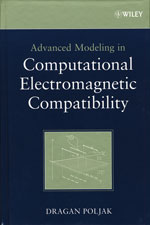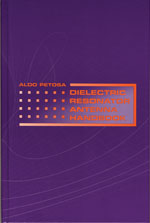Advanced Modeling in Computational Electromagnetic Compatibility
Dragan Poljak
Wiley Interscience • 514 pages; $125
ISBN-13: 978-0-470-03665-5
 Electromagnetic compatibility (EMC) is the applied discipline within the science of electromagnetism including almost all relevant areas of theoretical (computational) and experimental electromagnetics. Theoretical methods in electromagnetics can be classified as analytical or numerical and this book is strictly related to the numerical methods in EMC. The book starts by providing a crash course in fundamentals of electromagnetic theory and numerical modeling, then covers a frequency and time domain wire antenna analysis, and finally deals with modeling of a broad range of EMC problems of interest. The book is divided into three parts. The first part deals with introductory topics in EMC, namely the fundamentals of electromagnetic theory, basics in numerical modeling and simple computational models in the analysis of static, quasi-static and scattering problems. The second part deals with an analysis of the wire antennas, using the frequency domain (FD) and the time domain (TD) integral equation formulation, respectively. The analysis of wire antennas in the frequency and time domain using numerical methods is presented through Chapters 7 to 9. The third part of the book deals with the solution of some specific EMC problems by means of the wire antenna theory presented in Part II. The applications of antenna models are related to above ground and below ground transmission lines, respectively, and grounding systems and the interaction of the human body with electromagnetic radiation. Chapters 10 to 12 deal with above ground and below ground cables, while the analysis of vertical and horizontal electrodes is undertaken in Chapter 13. The book contains several numerical examples pertaining to academic and real world problems.
Electromagnetic compatibility (EMC) is the applied discipline within the science of electromagnetism including almost all relevant areas of theoretical (computational) and experimental electromagnetics. Theoretical methods in electromagnetics can be classified as analytical or numerical and this book is strictly related to the numerical methods in EMC. The book starts by providing a crash course in fundamentals of electromagnetic theory and numerical modeling, then covers a frequency and time domain wire antenna analysis, and finally deals with modeling of a broad range of EMC problems of interest. The book is divided into three parts. The first part deals with introductory topics in EMC, namely the fundamentals of electromagnetic theory, basics in numerical modeling and simple computational models in the analysis of static, quasi-static and scattering problems. The second part deals with an analysis of the wire antennas, using the frequency domain (FD) and the time domain (TD) integral equation formulation, respectively. The analysis of wire antennas in the frequency and time domain using numerical methods is presented through Chapters 7 to 9. The third part of the book deals with the solution of some specific EMC problems by means of the wire antenna theory presented in Part II. The applications of antenna models are related to above ground and below ground transmission lines, respectively, and grounding systems and the interaction of the human body with electromagnetic radiation. Chapters 10 to 12 deal with above ground and below ground cables, while the analysis of vertical and horizontal electrodes is undertaken in Chapter 13. The book contains several numerical examples pertaining to academic and real world problems.
To order this book, contact: John Wiley & Sons Inc.
One Wiley Drive
Somerset, NJ 08875
(800) 225-5945
Dielectric Resonator Antenna Handbook
Aldo Petosa
Artech House • 319 pages; $119, £66
ISBN-13: 978-1-59693-206-7
 This book brings together the rapidly growing body of knowledge on dielectric resonator antennas (DRA) into a single comprehensive volume. It serves as a good introductory text, providing detailed explanations of the modes of operation and radiation behavior of DRAs, describes the main methods of excitation and provides a thorough survey of the major advances in DRA technology. Chapter 1 begins with a brief history of DRAs, highlighting the main developments in this emerging technology. Chapter 2 introduces the three basic shapes of the DRA: hemispherical, cylindrical and rectangular, which are the most commonly used. Chapter 3 offers a brief review of coupling theory and an examination of the internal fields within rectangular and cylindrical DRAs. In Chapter 4, a survey of other DRA shapes is presented. Many of these DRAs are derived from the three basic shapes and are grouped accordingly. Chapter 5 examines the theoretical and practical lower limits of the Q-factor for cylindrical and rectangular DRAs and surveys the various techniques that have been used to enhance the operational bandwidth. Chapter 6 describes the techniques used to design low profile or compact DRAs. Chapter 7 examines DRAs designed for either circular or dual-linear polarization. Chapter 8 is devoted to DRAs that are fabricated from microwave ferrite materials for which the radiation properties can be electronically controlled by applying a magnetic field. Chapter 9 examines various configurations of linear and planar arrays of DRAs, highlights their performance and points out some of the challenges that exist. Chapter 10 considers various practical aspects associated with the fabrication and implementation of DRAs. Extensive bibliographies are given after each chapter.
This book brings together the rapidly growing body of knowledge on dielectric resonator antennas (DRA) into a single comprehensive volume. It serves as a good introductory text, providing detailed explanations of the modes of operation and radiation behavior of DRAs, describes the main methods of excitation and provides a thorough survey of the major advances in DRA technology. Chapter 1 begins with a brief history of DRAs, highlighting the main developments in this emerging technology. Chapter 2 introduces the three basic shapes of the DRA: hemispherical, cylindrical and rectangular, which are the most commonly used. Chapter 3 offers a brief review of coupling theory and an examination of the internal fields within rectangular and cylindrical DRAs. In Chapter 4, a survey of other DRA shapes is presented. Many of these DRAs are derived from the three basic shapes and are grouped accordingly. Chapter 5 examines the theoretical and practical lower limits of the Q-factor for cylindrical and rectangular DRAs and surveys the various techniques that have been used to enhance the operational bandwidth. Chapter 6 describes the techniques used to design low profile or compact DRAs. Chapter 7 examines DRAs designed for either circular or dual-linear polarization. Chapter 8 is devoted to DRAs that are fabricated from microwave ferrite materials for which the radiation properties can be electronically controlled by applying a magnetic field. Chapter 9 examines various configurations of linear and planar arrays of DRAs, highlights their performance and points out some of the challenges that exist. Chapter 10 considers various practical aspects associated with the fabrication and implementation of DRAs. Extensive bibliographies are given after each chapter.
To order this book, contact: Artech House
685 Canton St.
Norwood, MA 02062
(781) 769-9750 ext. 4030; or
46 Gillingham St.
London SW1V 1HH, UK
+44 (0) 207-8750
